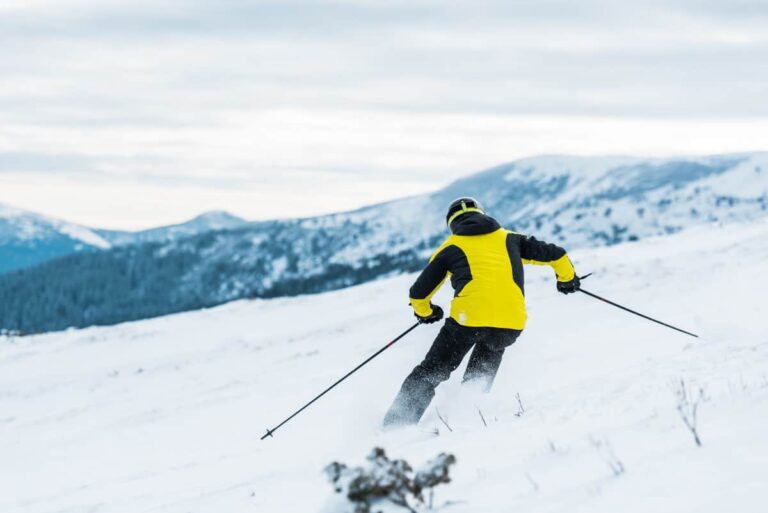The Best Knife for Skinning Deer: See Our Top Pick!
If you are in a hurry and just want to find out what the best skinning knife for deer is, then we recommend the Ka-Bar Becker BK2 Companion as the best all around.
All knives are not created equal when it comes to hunting knives! This is why we put in the time to find out what the best knife for skinning deer is. After doing hours upon hours of research, we’ve determined Ka-Bar Becker BK2 Companion is the best skinning knife on the market. This knife may be a newbie when it comes to hunting knives, but its quality ensures that it will be around for many years to come.
Although you can’t go wrong with choosing any of the knives on our list, it’s important to know what to look for in a good hunting knife. Our buyer’s guide will help walk you through what to look for and what to avoid in a good hunting knife.

In a Hurry? Here’s Our Top 3 Picks…
[amazon table=”7057″ link_id=”180″]
Buying Guide: What to Look for in a Skinning Knife
Knives have many different uses, and every hunter knows that you need the right knife for skinning and processing deer. You can’t take your fish filet knife out of the tackle box and expect it to slice through a deer’s hide as well as a knife that’s specifically made for this job.
To help you better understand what to look for in a good skinning knife, I have listed the 5 most important things to consider before making your next purchase.
Sharpness – Skinning and processing a deer requires some pretty well-placed cuts. It helps to know that your knife is up for the challenge and won’t let you down when the going gets tough. It needs to be sharp enough to make ultra-precise cuts.
Skinning and processing a deer is a time-consuming process, so you don’t want to waste any of your time having to stop and resharpen your blade. Having a blade that maintains its razor-sharp edge is critical.
Grip – The grip is something that not a lot of people consider when picking out a knife, but to be honest, cleaning a deer can be a dirty business. You want to make sure that you have a knife that is easy to hold on to so you can maintain a steady hand throughout the process.
Usually, the knives with the best grip will have some kind of rubber that allows you to maintain control even when the handle is bloody or wet. A lot of the wooden or plastic handles do not offer the same grip that a rubber handle will provide you. However, wooden handles are easier to clean.
Knives with rubber handles will hold onto more of the blood and debris that is associated with the skinning process, but still offer better grip.
Either way, you want to make sure the blade has an ergonomic grip that fits your hand and will allow you to use your knife like a pro.
Blade Choice – Throughout the years, knife manufacturers have continually tried to create new blades to match the needs of the modern hunter. All of the blades on the market can provide a hunter with a rather difficult decision when he is looking to purchase the right blade. Skinning knives are not built like other knives, and their blades are unique.
It can be hard not to get caught up in all of the new and different blades. I personally don’t see a need for anything crazy, because a traditional blade that is sharp is able to handle the toughest processing tasks.
Some hunters prefer to use spey blade because it comes with a blunt tip that helps in the skinning process. This blade helps to prevent you from accidentally puncturing the skin. However, if you are careful with the process, and take your time, a traditional blade is just as effective.
Another handy feature for any hunter processing his own game is the gut hook. This allows a hunter to make one incision and use the hook to make a cut with the hook directly down the animal without worrying about cutting the entrails, which can spoil the meat.
However, I will say that some hunters are turned off by gut-hooks. They claim that while they are great for splitting the deer’s hide in half, they tend to get caught on everything else when you’re processing the meat.
Fixed or Folding – The two most common types of knives are fixed or folding. A fixed knife is attached to a handle and usually comes with a sheath. A folding knife can open and close and will usually come with a little carrying case as well.
The fixed or folding debate usually comes down to the individual hunter’s preference. They both have their advantages and disadvantages.
A fixed blade is much easier to clean. When you are processing a deer, you simply have to wipe the blade clean when you are done. The Fixed blade is usually built from stronger material. The blade usually runs through the handle providing a stable platform.
It also has little moving parts, so they are more durable and less like to malfunction. They are generally harder to stow and take up more room in any bag you may carry, and they also get in the way when you sit down.
The folding blade is the exact opposite. It can easily fold and become twice as small. This allows you to stow the blade away in a bag or even in your pocket. However, the folding blade allows for more blood and debris to get into the folding mechanism and can be a pain to clean at times.
Durability – As with any piece of hunting equipment you need to invest in something that will last a long time. When a knife is well built and taken care of properly, they can often times become a family heirloom that can be passed down from generation to generation. I actually was given my first knife by my grandfather. It was an old folding buck knife.
You want to buy a knife that is sturdy and will survive the test of time. As hunters, we know that we are generally in austere conditions and we need to rely on our equipment in every kind of climate. Buying a knife with a good blade and a sturdy handle is one of the best investments we can make as a hunter.
We owe it to the animal that we harvest to guarantee that we take as much meat as we can. You want to have a knife that is able to make the best cuts and will not break halfway through the process. Also, many knife companies will offer lifetime warranties or knife sharpening, so that may be something to consider when purchasing a knife.
Reviews: Best Skinning Knife for Deer
Ka-Bar Becker BK2 Companion
[amazon box=”B001N1DPDE” template=”horizontal” link_id=”181″]
Ka-Bar has been the trusted knife of the United States Marine Corps for generations, and their hunting knives are built to the same quality as their military knives. The Becker BK2 Companion knife is meant to the be a multi-use knife. It’s fixed blade knife that is heavier than most and will ensure long-lasting durability.
The sheath that comes with it allows you to wear it on your hip or attach it to your pack.
The blade itself features a drop tip point blade that helps with skinning deer. It also has a versatile 20-degree blade which aids in processing deer. It is a heavy knife made of steel, and the blade itself is 5.5 inches long which is a little larger than most hunting knives. A longer blade can be more difficult to reach into certain spots when skinning and processing an animal.
However, it does have a handle made with “Grivory” which provides the user with a grip and control in any condition. Overall this is a good hunting and camping knife and will offer the user a lot of versatility in how he decides to use it.
Case Gut Hook Hunting Knife
[amazon box=”B00062B2FE” template=”horizontal” link_id=”182″]
The Case Gut hook hunting knife is another fixed blade knife that offers every hunter with a great affordable choice for any of his deer skinning needs. Each one of the blades is made from Tru Sharp surgical stainless steel to provide the hunter with a blade that will keep its sharpness throughout its use.
The knife is 8 inches overall, and the blade itself is four inches which is a great size for easy skinning and processing deer. This knife is lightweight coming in at 4.8 ounces which is perfect for any hunter that has to travel long distances and wants to cut down on weight. While it is lightweight, it does have a thin blade which some do not like when deboning a deer.
The case knife is a good knife for anyone that wants to keep the weight to a minimum. The gut hook feature helps hunters speed up the gutting process without running the risk of cutting the entrails and spoiling the meat. It’s a little on the smaller size for a fixed blade, so it can easily be stowed in a bag. It also has a number of different varieties if the gut hook knife isn’t exactly what you are looking for.
Benchmade – Grizzly Creek Knife
[amazon box=”B00JDTAKKE” template=”horizontal” link_id=”184″]
Benchmade is a newer brand that was found in 1988 but don’t let that fool you. Benchmade produces some of the highest quality knives that are built to last. When you invest in a Benchmade you invest for a lifetime, as all of their knives come with a lifetime guarantee and the life sharp service which promises to repair and sharpen your knife for forever.
The Grizzly Creek Knife 15060-2 is one a knife that is built for hunting. It is a folding blade knife with a solid lock mechanism that is built to last in the worst conditions. Since it is a folding knife blade, it will need more careful cleaning to prevent moisture and blood from corroding the knife. Its drop point blade is great for deboning which is an important part of processing a deer. It does not offer the grip that a rubber handle would so it may be harder to grasp while in use.
Lastly, it features a gut hook which can be unlatched by the locking mechamism.
This is a great knife to have when you are cleaning your latest kill, and that is why it is at the top of the list.
Buck Knives 113 Ranger
[amazon box=”B004NJ2ETY” template=”horizontal” link_id=”185″]
The Buck Ranger 113 is another great knife for skinning a deer. This fixed blade knife offers a hunter a number of advantages over the traditional folding buck knife. While it is meant for skinning deer, it will also act as a great knife for processing deer as well.
This blade comes with a drop point skinner blade, and it also has corrosion resistant metal that will protect your blade from corrosion in the worst environments imaginable.
The blade is optimized for performance for skinning with a narrow tip and a thicker wider curved belly. This allows you to quickly work your way through thick layers and prevent you from puncturing the skin. However, this blade does not come with a rubber handle. Instead, it has a walnut handle which may be harder to grasp during the skinning process.
While it may not be rubber, the handle has an ergonomic design that will fit comfortably in any hunters hand. It also comes with the forever warranty that is provided for every Buck knife. This is one of those knives that if cared for properly can be passed down for generations.
Conclusion
You’ve put in the time all year! You’ve searched for the perfect spot to hang your tree stand, you’ve made sure that your weapon of choice is ready to go and you’ve selected the best camo pattern for your terrain. However, did you make sure that your skinning knife is up for the challenge just in case you bag the buck of a lifetime?
Skinning a deer can be a difficult task, especially if you don’t have the right knife for the job! Lucky for you, we’ve put in the time to find the best knife for skinning deer on the market today, along with a few other top choices. All you have to do is choose the one that’s right for you. Will it be Benchmade’s Saddle Mountain Hunter, will go with the time-tested Buck Open Season Skinner?


